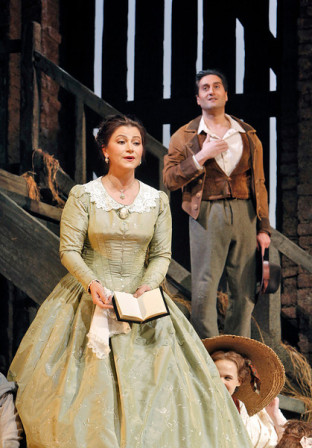Hello again from San Diego Opera!

Soprano Tatiana Lisnic is Adina and tenor Giuseppe Filianoti is Nemorino in San Diego Opera’s “The Elixir of Love.” Photo by Cory Weaver.
by Karen Keltner, resident conductor and music administrator
I’m writing to you on the day of San Diego Opera’s second opening night in its 2014 season. “Pagliacci” closed after four successful performances, and we are now poised to do a 180 degree turn to the lively and sweetly amusing opera comedy which is Donizetti’s “Elixir of Love.” We’ve moved backward stylistically from “Pagliacci’s” verismo style which depicts in musical and dramatic terms life as it exists in reality with no “sugar-coating” to Donizetti’s “Elixir of Love,” which focuses on the beauty and the pyrotechnical skill of the human voice—-the belle canto, beautiful singing period of opera.
The stage director in a new production sets the tone for the entire physical look of the opera he or she is designing—the set and the time period in which the opera will take place, the costumes, the props, the lighting….every non-musical aspect of the show. And first and foremost among those responsibilities is directing the principal singers and the chorus in their stage action and, in the case of the principal artists, delineating the characterizations of the roles sung by the principal artists whom you see and hear onstage in major singing roles.
In the very broadest sense of the word and in the early days of opera production, every indication is that singers simply stood and sang—-the voice was the primary concern and the delivery of the vocal product was what mattered most to an audience. Those vocal values still hold true today, but with the advancement of technology in film, television, and recording coupled with the speed with which each of those areas has progressed, audiences today are no longer content with the “stand and sing” school of opera performance (or in opera jargon, the “park and bark” form of delivery)—static, mannered, and decidedly old-fashioned. Film and television have created an audience who expect and demand singing actors who deliver the same quality of credible acting to the opera medium as exists in fine theatre. Today’s singing artists must not only deliver an outstanding vocal product, but must also possess the acting skills and the “look” expected of their counterparts in straight theatre.
An opera stage director’s job then is extremely demanding: to coach, urge, cajole and otherwise bring forth from these singing actors a believable performance dramatically as well as vocally.
Obviously, as in all art forms, individual talents vary and personalities either “click” with a certain chemistry or not. A skilled director knows how to approach each of his individual singing artists so as to guide the various interactions of those artists in a way which delivers credible characters and a believable story-line across the footlights into the house, guiding and leading singers whose primary life training has been the development, care and feeding of a beautiful vocal instrument. Not an easy task, and as is so often the case in opera production in the United States, it is a task which must be accomplished in a much shorter time period than is provided in straight theatre. Opera expenses are by nature the highest of all the art forms, and hence the time for preparation is necessarily limited…a strange and unfortunate paradox in the most complex of all the art.
My opinion is that the best stage director is one who quickly assesses the dramatic gifts and/or limitations of his singing cast and then goes about the job of bringing out in each artist the strengths which that individual possesses. Dictating to a singer an action or a specific movement to happen in a particular physical manner at a particular point in the music is often a disaster: the dictated action looks forced or otherwise unnatural and the singer is often visibly uncomfortable performing that action.
A better choice is to express to the singer what the director believes should be happening and why and then giving to the singer the responsibility of conveying that action, thus using the unique attributes of that individual performer. At that point, when the singer’s attempt has been put forth and viewed by the director, further detail can then be added—refinement or “tweaking” to what the singer has tried or an outright request that the singer try something else, but only after that artist has been first been invited to bring her or his unique “take” to the table. I have always been baffled by a director who states up top that he is eager to see what his performers can bring to their individual characterizations and then proceeds to micromanage anything that a performer offers.
But that approach anymore is happily rare, just as the conductor-as-dictator is a thing of the past. Artists of so many genres join together in the interest of one common goal: to make the most of the show, in the best way possible.
In one of the truest forms of collaboration, an opera takes shape through the gifts of talented directors, conductors, and singing artists all united in a triumph of teamwork— heard and unheard, seen and unseen.
Category: Entertainment, Music







